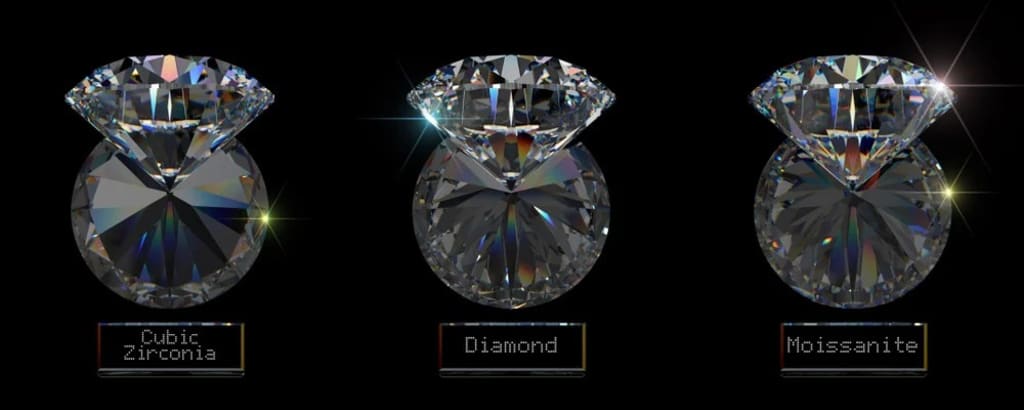Moissanite VS. Diamond VS. Cubic Zirconia
Difference Between Moissanite & Diamond & Cubic Zirconia

While deciding between a moissanite band and a cubic zirconia ring, the gemstone quality should be considered. Moissanite is a more durable gemstone than cubic zirconia, making it the most popular choice for engagement rings. The light will be remembered more strongly from its surface due to its high refractive index and arrangement. Another element that makes Moissanite a good choice for engagement rings is the gemstone's inexpensive cost. It's also a great option to a transparent gemstone because it's less prone to be scratched.
The cost of an engagement ring is usually one of the most important considerations when selecting a style, metal, and gemstone. Should your engagement ring be made of traditional diamonds or an artificial stone such as Moissanite or cubic zirconium? First and foremost, it is vital to understand the differences between the two. Despite the fact that many people believe the variations between Moissanite, cubic zirconium, and diamonds are small, each stone leaves an impression.
Moissanite Vs. Diamond Vs. Cubic Zirconia
What is Moissanite?
Unlike most other gemstones, Moissanite is literally from another planet. Henri Moissan discovered Moissanite in 1893 when he discovered minute particles of what is now known as Moissanite in a hole left by a meteorite strike in Arizona. Moissan was the first person to discover Moissanite. Moissan initially thought he'd discovered diamonds, but upon closer inspection, he discovered the particles were made of silicon carbide rather than carbon.
Because moissanite is extremely rare in nature, most moissanite stones are now manufactured in laboratories. Although though Moissanite is designed to resemble diamonds, there are significant variances between the two.
Moissanite Vs Diamond
Moissanite has a lower hardness rating on the Mohs Scale of Hardness than diamonds. Despite having a hardness of 9.25, the diamond receives a perfect ten (making it an extremely durable stone). The.75 difference is insufficient to overshadow Moissanite's better durability. Neither stone is too delicate to be worn as an engagement ring on a daily basis. As it reaches hardness, a diamond remains the gold standard.
Because of its arrangement, Moissanite has a distinct influence on intelligence than a diamond. Moissanite's faceted structure produces a rainbow-like look when worn. While some consumers adore the flare of colour, others say the stone is closer to a disco ball than a diamond. The significance of this impact grows with the size of the stone. Diamonds, on the other hand, are simply concerned with displaying their renowned radiance.
Although colourless diamonds appear white, so-called "colourless" Moissanite can arrive with a yellowish or greyish hue. It compensates for Moissanite's shortcomings in hardness, polish, and colour by being less expensive. Moissanite engagement rings are significantly less expensive than diamond engagement rings. Although while lab-created diamonds are less expensive than naturally occurring diamonds, they are still more expensive than Moissanite.
Cubic Zirconia Origins
Cubic zirconia engagement rings are a popular alternative to diamond engagement rings. This stone is made in a laboratory, yet it is intended to have the same radiance as a natural diamond. The cubic crystal balance of zirconium oxide, as well as its chemical makeup, give it its name.
Cubic zirconia is highly valued since it requires little maintenance while conjuring up visions of diamonds in the minds of customers. Cubic zirconia, unlike Moissanite, can be produced completely colourless, bringing it on par with diamonds in terms of colour.
German mineralogists were among the first to identify naturally occurring cubic zirconia. Yet, it wasn't until the 1960s that single-crystal cubic zirconia manufacture began, and the Russians eventually mastered the technology. Despite the fact that lab-grown diamonds and cubic zirconia are both created artificially, there is a significant difference between the two. In contrast to cubic zirconia, which was produced to mimic diamond formation, lab-grown diamonds are totally composed of carbon atoms (as opposed to mined or natural diamonds).
Diamond Vs. Cubic Zirconia
When compared to diamonds, cubic zirconia is far less expensive. As a result, cubic zirconia may be a low-cost solution for any consumer seeking a certain setting, design, or engagement ring. Also, when ordering cubic zirconia instead of diamonds, the wait times are frequently significantly shorter.
Even though cubic zirconia is still durable, its hardness does not match that of a diamond; cubic zirconia has a Mohs hardness rating of 8.5. CZ, on the other hand, is naturally perfect because it was created in a laboratory. Diamonds, on the other hand, are rarely (if ever) flawless in appearance.
If you want a stone that sparkles, a diamond is your best bet. Cubic zirconia gathers light differently and shines less than diamond because it has a far lower refractive index.
Every gemstone has advantages and disadvantages, but a diamond is the most commonly used jewel in an engagement ring. A diamond (whether mined or manufactured in a laboratory) has a Mohs hardness rating of 10, making it durable and suitable for everyday wear. Furthermore, the colour is pure, with no yellow or grey undertones; no other diamond alternative comes close in terms of sparkle and radiance.
Of course, a diamond's price is normally more than its value, but its value is also higher. This will produce a considerably more durable and intelligent stone for the wearer, who will be delighted to show off their diamond engagement ring to family and friends.
Moissanite Vs. Cubic Zirconia
Moissanite is a harder gemstone than Cubic Zirconia. According to the Knoop indentation test, CZ possesses less than half (45%) the hardness of Moissanite when it comes to hardness (which measures hardness). According to the test results, CZ 1370 exceeds Moissanite 3000, implying that Moissanite is 219 percent harder than diamond.
Moissanite comes out on top when it comes to comparable toughness, which is the resistance to chipping and breaking, with its chipping resistance being over 300 percent more than that of a diamond. A CZ has a PSI of 2.4, but Moissanite has a PSI of 7.6. Moissanites, due to their extreme hardness and endurance, will not scrape, chip, or wear like a CZ stone.
In addition to having a high refractive index of 2.69, Moissanite has a refractive index that is 25% higher than that of diamond. The higher a gemstone's refractive index, the more light it emits when illuminated. Moissanite has a 58 percent greater light dispersion than cubic zirconia. As a result, Moissanite is associated with fire and flashes of rainbow light rather than cubic zirconia. Moissanite has a shine that is 50% more than that of cubic zirconia. The greater the lustre of a gemstone, the greater the amount of light reflected off its facetted surface.
Moissanite has more heat tolerance than CZ, a heat-sensitive gemstone. If you want to develop a cubic zirconia stone, some jewellers may refuse your request for adjustments to your CZ jewellery, such as sizing or repairs.
Conclusion
Even though cubic zirconia (CZ) is a more economical choice, Moissanite is the central diamond simulant due to its durability, brightness, and overall worth, making it the superior pick. Nothing can correspond to a diamond in stature and class, yet Moissanite seems near. Unfortunately, CZ will invariably be sensed as inexpensive and of little value.
About the Creator
vihar vaghasiya
I am an entrepreneur and a content writer. I am making a blog to share my experiences with others. My blog is a mixture of general lifestyle, fashion and style tips. My motto is that life must be aesthetic as well as practical.






Comments
There are no comments for this story
Be the first to respond and start the conversation.